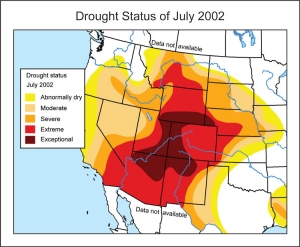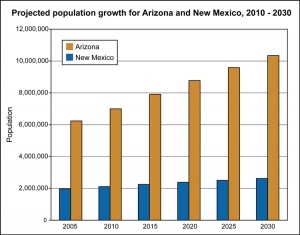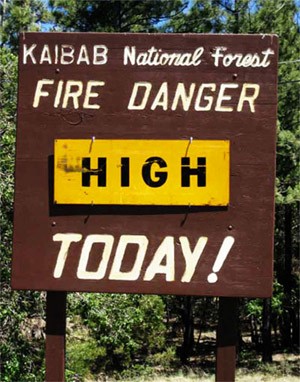Drought and People
Water is a critical natural resource for people in the arid Southwest, as the region is highly susceptible to drought. Climate change impacts on southwest drought could thus have profound implications for society. Global climate projections indicate the future holds higher annual temperatures and less winter precipitation for the Southwest. These warmer temperatures may intensify the impact of drought on residents of the Southwest: recent research links the regional drought that peaked in intensity in summer 2002 (Figure 1) with more severe impacts on water, land, and people, than previous, drier droughts, due to warmer temperatures.

Figure 1. Peak drought intensity. The peak intensity of the drought that began in the late 1990s occurred in 2002 and 2003. Using data from the U.S. Drought Monitor maps archive, this figure shows how the drought affected the entire Southwest. Extreme drought conditions very likely extended well into Mexico despite lack of data available to the U.S. Drought Monitor at that time.
| Enlarge This Figure |
Credit: Joe Abraham, Institute of the Environment, The University of Arizona
More intense periods of drought will affect many aspects of society, including:
- Water supply
- Urban populations
- Regional economy
Water Supply
Climate change will impact the water supply of the region in several ways. Drier winters will diminish the natural recharge of the Southwest’s underground aquifers. Reduced snowfall in the Rockies and other mountain ranges in Arizona and New Mexico means less water flowing into the region’s reservoirs, on average. A shift towards earlier snowmelt due to warmer temperatures will extend the dry season before the summer monsoon, stressing water supplies and increasing demand for water during this period. With higher temperatures, evaporation rates will increase, affecting lakes, reservoirs, soil moisture, and plants.
Phoenix and Tucson store excess water allocations in Lakes Mead and Powell on the Colorado River. This water buffers the cities against short- and long-term droughts that impact regional water resources. But over time, climate change and increasing demand for water may reduce this excess water.
Water storage serves another purpose: it produces hydroelectric power. Together, Lakes Powell and Mead can produce up to 10,000 gigawatt-hours of energy; combined with other hydroelectric power plants, these reservoirs produce between 6.5 to 8 percent of Arizona’s electricity. Projected regional climate changes may reduce the amount of power these reservoirs can produce. For example, climate models forecast a 10 to 18 percent reduction in Colorado River streamflow that could drain water storage by 35 to 40 percent, reducing hydroelectric productivity by 45 to 56 percent.5 Less hydropower production due to low reservoir levels means less energy available for the quickly growing Southwest population.
Urban populations

Figure 2. Projected population growth for Arizona and New Mexico, 2010 - 2030.
| Enlarge This Figure |
Credit: Joe Abraham, Institute of the Environment, The University of Arizona
A stressed water supply plus population growth translates into more competition and higher costs for water. The Southwest is one of the fastest growing regions in the country. In the 1990s, Arizona’s population increased by 40 percent and New Mexico's by 20 percent while the national average during that decade was 13 percent.8 Projections through 2030 show population increases of 66 percent for Arizona6 and 33 percent for New Mexico (Figure 2).
These population estimates combined with regional climate projections may mean that all residents will not receive adequate water supplies, particularly in areas where demand challenges supply. Some people, including more 100,000 residents of colonias in New Mexico, already have limited access to clean water and would be unable to afford to pay more for it. Colonias are areas of high poverty that lie outside city limits, usually along the U.S.-Mexico border, and often lack public infrastructure like plumbing, garbage service, or roads.8 These communities are extremely vulnerable to drought-induced health effects, such as increased disease transmission through water-borne vectors due to poor water quality.
Regional economy
All economic sectors depend on a steady water supply to keep their industries and employees functioning. Drought can impact service industries, retail sales, and general trade, all of which affect the regional economy. However, some sectors in the Southwest are more susceptible than others to the impacts of drought, especially rain-fed agriculture and outdoor tourism and recreation.

Climate change is projected to worsen wildfire risk in the Southwest that in turn impacts rural economies.
Credit: U.S. Forest Service
Agriculture in the Southwest already competes with other sectors for water and land, regardless of regional drought. In Arizona, agriculture currently uses about 80 percent of the state’s water. Limited supplies due to drought conditions will exacerbate water conflicts between urban populations, commerce and industry, energy producers, and natural environments. Water may shift from agricultural use to urban use as the demand for water in the Southwest continues to grow.
The agricultural sector in the Southwest is dependent upon a regular water supply, and will suffer economically from intensified drought and climate change. Drought not only implies direct effects on crops or livestock, but also a myriad of indirect effects. For farmers, drought might mean increased water costs, a reduction in crop yields or crop quality, increased threat of pests, weeds, or diseases signifying higher management costs for pesticides, herbicides, and fertilizers. For ranchers, drought may lead to animal mortality or disease, increased threat of predation, cattle sell offs, a reduction in livestock forage, and higher costs for supplemental feed or water. Retailers who provide services and goods to farmers and ranchers could also face reduced business, creating a ripple effect towards a weak economy.
Crops that are particularly weather sensitive will be more vulnerable to drought and climate change. For example, production of wheat and sorghum in New Mexico (which occupies 42 percent of the state’s agricultural land) declined during drought events in the 1990s. Irrigated agriculture in the Southwest has shifted from crops like cotton to more water-intensive vegetables and cattle feed like alfalfa. Not only do these particular crops demand a lot of water, but they also lose a lot of water to evaporation through storage and transportation and through the soil and plants themselves.
Tourism and recreation will also experience economic impacts due to increased drought frequency and severity. Levels of lakes and rivers will decrease, as will snowfall in the mountains. Trees will suffer with less moisture, becoming susceptible to pests and disease; this can lead to increased wildfires and wildlife habitat degradation. These lakes, snowfall, mountains, and other natural features provide the basis for outdoor tourism and recreation activities, including water sports, skiing, hiking, and camping, as well as local economies that support these activities. Studies show the number of visits to national parks in the Southwest decrease due to side effects of drought, such as lower lake levels and wildfires. People with jobs in tourism and recreation industries may suffer economic effects with decreased visitation. For example, the 5.4 percent drop in water level at Lake Powell from 1999 to 2003 contributed to half a million fewer visits to the Glen Canyon National Recreation Area in 2003. This plummet in visitors brought a loss of $32.1 million in spending in the area, along with 758 jobs and $13.4 million in personal income.
References
- Breshears, D., et al. 2005. Regional vegetation die-off in response to global-change-type drought. Proceedings of the National Academy of Sciences, 102:15144–15148.
- Jacobs, K. and J. Holway. 2004. Managing for sustainability in an arid climate: Lessons learned from 20 years of groundwater management in Arizona, USA. Hydrogeology Journal, 12:52-65.
- Barnett, T. and D. Pierce. 2008. When will Lake Mead go dry? Water Resources Research, 44:W03201.
- Energy Information Administration. 2006. Table 5. Electric Power Industry Generation by Primary Energy Source, 1990 Through 2007. http://www.eia.doe.gov/cneaf/electricity/st_profiles/sept05az.xls (Last accessed October 2008).
- Christensen, N., et al. 2004. The effects of climate change on the hydrology and water resources of the Colorado River Basin. Climatic Change, 62: 337-363.
- Arizona Department of Commerce. 2006. State and County Projections in Detail. http://www.azcommerce.com/doclib/econinfo/FILES/2006-2055ArizonaProjecti... (Last accessed October 2008).
- Bureau of Business and Economic Research. 2004. Population Projections by County, 1990-2030. http://bber.unm.edu/demo/table1.htm (Last accessed October 2008).
- Liverman D. and R. Merideth. 2002. Climate and society in the US Southwest: The context for a regional assessment. Climate Research, 21:199-218.
- Ponnaluru, S. 2005. Visitation to the national parks of the Southwest: The influence of economic and climate variables. MS Thesis. Department of Agricultural and Resource Economics, University of Arizona.

